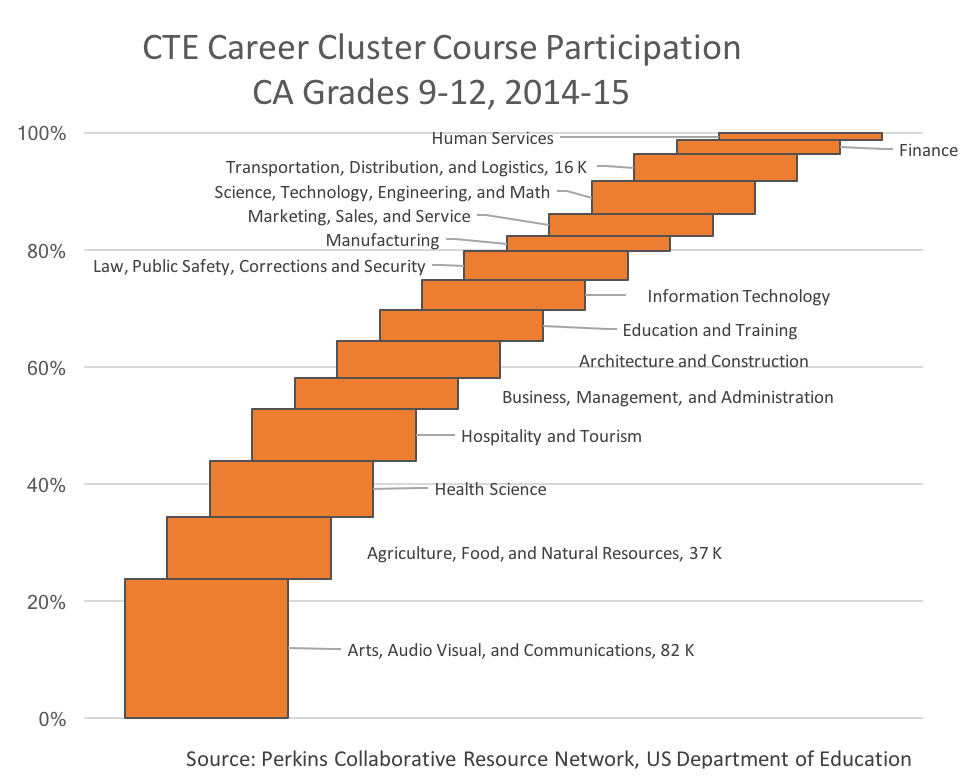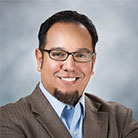
Should high school prepare you for college, or for work?
In This Lesson

What is Career Technical Education (CTE)?
How can students get jobs after high school?
How can I find an internship for a high school student?
What is dual enrollment?
What is vocational education?
What is ROCP?
What is Linked Learning? Does it work?
▶ Watch the video summary
★ Discussion Guide
The dominant answer to this question has changed over time.
California's high schools once were designed with a strong emphasis on career. As recently as 1987, nearly three-quarters of high school students were enrolled in courses explicitly designed to prepare them for a career — or at least for a job.
At the time, career-oriented education was widely known as vocational education. Vocational-track courses were offered in high schools, sometimes with funding through regional partnerships with local employers. Regional Occupational Centers and Programs (ROCPs) received dedicated funding and served many thousands of students in the state.
The nature of the economy changed dramatically in the 1980s and 1990s as intangible assets associated with knowledge work grew in value and overtook the economy of tangible assets. (See Ed100 Lesson 1.3) High schools, under terrible budget pressure after the passage of Proposition 13, had to make tough choices. Big employers were making tough choices, too, and many jobs were disappearing. The future seemed clear: college was becoming the pathway to a middle-class life.
To give as many students as possible access to that pathway, schools focused on academics. In 2000, the leaders of California’s four-year public college systems (UC and CSU) jointly defined a rigorous set of course requirements for college admission, which would become known as the a-g requirements. (See Lesson 6.2 for more.) A bipartisan consensus in Congress passed the No Child Left Behind Act (NCLB) in 2001, reinforcing the growing emphasis on testable progress in reading, writing and math.
NCLB had many problems, but it played a transformative role in the evolution of education policy in America. It compelled districts to measure success on the basis of students’ individual academic performance, which exposed race-based patterns of low academic expectations. It was no longer legally acceptable for high schools to track “those kids” to vocational classes and “these kids” to academic ones. Vocational education was firmly out of fashion.
Funding for ROCP programs dwindled, and the programs shrank, never to recover. (As of 2021, the remaining ROCP programs in California, sustained by Federal workforce grants, served fewer than 1,800 students.)
Career Technical Education makes a comeback, of sorts
The systemic emphasis on college readiness had an obvious dark side: only a third of students go on to earn a college degree. What about the rest? What was the education system’s vision for successful career readiness independent of college readiness? The legislature handed the question to the California State Board of Education (SBE), which in 2005 adopted a comprehensive set of model curriculum standards designed for grades 7-12. It was a huge undertaking. The standards specified general knowledge and specific career-related skills necessary to achieve learning goals in 58 career pathways in 15 industry sectors.
These standards were updated in 2013, the same year that California and most other states adopted the Common Core State Standards. As explained in Lesson 6.1, these standards aimed to define the skills necessary to be ready for success in both college and career.
In 2016, Education Trust-West examined the role of career-oriented courses in students' "pathways" after high school. In a study titled Meandering toward Graduation: Transcript Outcomes of High School Graduates, the authors documented extensive mismatches between the courses students take and the courses they ought to take in order to be ready for college or career.
 Over a fifth of career-oriented high school courses taken in California in 2014-15 were in "arts, audio-visual and communications" subjects
Over a fifth of career-oriented high school courses taken in California in 2014-15 were in "arts, audio-visual and communications" subjects
Did these career pathways actually work, or were they just a fancy way of lowering expectations and avoiding real equity in education access? Researchers pounced on the question.
In 2018, as part of the Getting Down to Facts II project, researchers from UC Davis and elsewhere examined the success of CTE Pathways in A Portrait of California Career Technical Education Pathway Completers. A key motivating question of this study was to look for evidence of academic harm. Were there important patterns in which students had access to CTE courses? When students were offered career-oriented courses, do they lose interest in math and reading?
On average, the study found little difference:
“Collectively, this evidence dispels any myths that CTE programs serve students with lower academic ability. In fact in a number of the more technical fields, CTE students outperform their non-CTE peers. Yet, even in those fields where academic performance is lower than the cohort average, this descriptive evidence only illuminates differences most likely driven by student selection rather than program quality.”
At the same time as the Common Core was being adopted, school districts in California were given new flexibility to allocate their budgets. (See Lesson 8.5.) A period of experimentation ensued, spurred by a succession of modest state grant programs under terms like Partnership Academies and Career Pathways. Perhaps the most successful buzzword associated with this general idea became Linked Learning.
Listen to Carol's interview with Eric Rice, Director of College & Career Pathways in the San Francisco Unified School District
Differing views about CTE and Linked Learning
Vocationally-oriented programs, when effective, can serve as a pipeline connection between high schools and employers. On one hand, this type of program is great, right? Participating students graduate directly to jobs in their community, and local employers build a deep connection with local schools. For some students, CTE helps increase their motivation and engagement with school by connecting schoolwork with the real world.
On the other hand, such pipelines raise civil rights concerns. A long-term study of economic microdata in the United States and other countries shows that over the course of time, students that pursue a career-oriented track in school tend to have "less adaptability and diminished employment later in life." If schools direct low-income students and students of color into career-oriented programs rather than college-oriented ones, they perpetuate economic divisions.
According to a 2016 poll by the Public Policy Institute of California (PPIC), Californians broadly agree with the statement “a college education is necessary for a person to be successful in today's work world.” The poll found particular agreement with the statement among respondents who were nonwhite or who had lower household incomes. Only respondents who were white or who had higher incomes were more likely to agree with the statement “there are many ways to succeed in today's work world without a college education.”
 Source: PPIC statewide survey "Californians & Higher Education", Dec 2016.
Source: PPIC statewide survey "Californians & Higher Education", Dec 2016.
What is Dual Enrollment?
Career Technical Education and Linked Learning began as education reform strategies for high schools, but in 2016 California followed other states by evolving toward a strategy that includes community colleges.
California’s public community colleges are located all over the state. These colleges have become the heart of career-oriented education in California. Anyone can enroll for credit, including high school students, who can dual-enroll to earn both high school credit and college credit. In 2022, the Office of the California Legislative Analyst (LAO) studied plans to expand dual enrollment in California. The timing of the proposal was important: enrollment in community colleges had dipped in the pandemic, and the state was enjoying a boom in tax receipts.
Internships
Internships for high school students are rare. High school students fortunate enough to land an internship gain experiences that can help them see their own future in a way that classroom experiences alone cannot deliver. An internship can also assist a student with determining whether or not they are on the right career path. And it’s often the first time that they must prepare a resume and practice job-interviewing skills.
Setting up effective internships is challenging. Schools must include local employers in planning and developing educational programs. Crossing organizational boundaries to create public-private partnerships has proved difficult. School districts have the authority to invest in such programs, but tradeoffs are always difficult to make.
Unsurprisingly, the internet has sprouted solutions that savvy students can use to search for internships and other opportunities, such as idealist.org.
Buzzword Summary
All of the following buzzwords relate to efforts to combine learning and career. Pay attention, now - there could be a test. Just sayin'.
- Linked Learning
- Vocational Education
- Career Technical Education (CTE)
- Regional Occupational Centers and Programs (ROCPs)
- Internships
- Dual enrollment
Notice that "blended learning" is not on this list? That's because blended learning refers to the use of technology for learning in classrooms. Ah, the joys of education jargon...
Divided opinion
No, there is not universal agreement that all high schools should emphasize CTE, or support internships, or use the Linked Learning approach. CTE has opponents as well as advocates. Some college advocates view CTE as a distraction from the hard work of creating and executing successful college-preparatory programs.
Realistically, not all students (or parents) want the same things out of their high school education, but nearly all see some college or other postsecondary education in their future. School districts need to be equipped to deliver both types of instruction at a high level of quality and in a way that no student is shut out from the classes they need.
Updated July 2017
November 2018
November 2022
CHAPTER 6:
The Right Stuff
-
The Right Stuff
Overview of Chapter 6 -
Grade-Level Standards
What is the Common Core? -
Is School Challenging Enough?
Academic Rigor -
Literacy in California
Ensuring All Kids Can Read, Write and Speak English -
STEM Education in California
Science, Technology, Engineering and Math -
Why Are Tests Important?
Why Tests Matter and How They Work -
Technology in Education
Tools for Teaching and Learning -
Student Engagement
How to Make School Interesting -
Arts Education
Creativity in California Schools -
P.E. and School Sports
How Does Sweat and Movement Help Learning? -
Field Trips
Beyond the Classroom -
Career Technical Education
Vocational Learning, Dual-Enrollment, and Internships -
Service Learning
Civic Engagement and Helping Others -
Teaching Soft Skills
Social-Emotional Learning -
Can Values and Habits be Taught?
Character Education -
Civics, History and Geography
How Do Kids Learn About Their Country and the World? -
How do Kids Become Bilingual?
World Language Learning in California Schools -
Financial Literacy in California
Learning to Earn
Related
Sharing is caring!
Password Reset
Search all lesson and blog content here.
Login with Email
We will send your Login Link to your email
address. Click on the link and you will be
logged into Ed100. No more passwords to
remember!














Questions & Comments
To comment or reply, please sign in .
Carol Kocivar April 24, 2025 at 12:15 pm
Looking for a comprehensive update on career technical education in California? Here is a report for you from the office of the California Legislative Analyst.
Carol Kocivar April 5, 2025 at 10:36 am
"The Master Plan... provides a framework for responding to the complex, multifaceted challenges confronting California’s labor market and educational landscape. This plan, which builds on the 1960 plan, acknowledges the shifting demographics of college attendees and the changing nature of work—with automation and artificial intelligence reshaping job categories and skill requirements—and provides flexibility to address new challenges that will emerge in the future. In addition to identifying priority areas for future action, it provides examples of work already underway that could be scaled and replicated to attain shared goals."
Carol Kocivar April 26, 2023 at 5:11 pm
From the Hechinger Report--Trade programs — unlike other areas of higher education — are in hot demand.
Many young people choose to pursue short-term credentials over traditional college because they see them as a quicker and a more affordable path to a good job.
https://hechingerreport.org/trade-programs-unlike-other-areas-of-higher-education-are-in-hot-demand/
Carol Kocivar August 4, 2022 at 1:08 pm
$500 million one-time over seven years to support the development of pathway programs focused on technology (including computer science, green technology, and engineering), health care, education (including early education), and climate-related fields. These programs are predicated on developing local partnerships that bring together school systems, higher education institutions, employers, and other relevant community stakeholders.
• $200 million one-time, available over five years, to strengthen and expand student access and participation in dual enrollment opportunities. Dual enrollment allows high school students to take classes that both count towards high school graduation and earning college credit, with some students able to graduate high school with an associate’s degree.
Jamie Kiffel-Alcheh November 15, 2019 at 8:14 pm
Jamie Kiffel-Alcheh November 15, 2019 at 9:18 am
“took a step toward concreteness by adopted”
It should say “adopting.”
Jeff Camp March 10, 2017 at 10:50 am
Albert Stroberg May 1, 2016 at 8:31 pm
Jeff Camp - Founder April 22, 2016 at 10:43 am
Stacey W April 27, 2015 at 10:55 pm
g4joer6 April 19, 2015 at 12:38 pm
CM January 19, 2015 at 3:55 pm